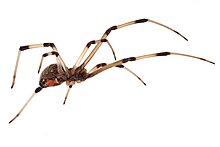Brown widow
| Latrodectus geometricus | |
|---|---|
 |
|
| Scientific classification | |
| Kingdom: | Animalia |
| Phylum: | Euarthropoda |
| Subphylum: | Chelicerata |
| Class: | Arachnida |
| Order: | Araneae |
| Infraorder: | Araneomorphae |
| Family: | Theridiidae |
| Genus: | Latrodectus |
| Species: | L. geometricus |
| Binomial name | |
|
Latrodectus geometricus Koch, 1841 |
|
| Synonyms | |
|
|
Latrodectus geometricus, commonly known as the brown widow,brown button spider, grey widow, brown black widow,house button spider or geometric button spider, is one of the widow spiders in the genus Latrodectus. As such, it is a 'cousin' to the more infamous Latrodectus mactans (black widow).
L. geometricus is slightly smaller and generally lighter in color than the black widow species; the color can range from tan to dark brown to black, with shades of grey also possible. Like the black widow species in the United States, L. geometricus has a prominent hourglass-shaped marking on the underside of the abdomen; the brown widow's hourglass, however, is usually a vivid orange or a yellowish color. Unlike the black widow, L. geometricus has a black-and-white geometric pattern on the dorsal side of its abdomen. Although the Latin name comes from this pattern, a spider's coloring can and does darken over time and the pattern may become obscured. Also, they have stripes on their legs. Brown widows are often preyed on by mud daubers and sometimes by digger wasps.
Brown widows can be located by finding their egg sacs, which are easily identifiable. They resemble a sandspur, having pointed projections all over, and they are sometimes described as "tufted", "fluffy", or "spiky" in appearance. Eggs hatch in approximately 20 days. Female brown widows "lay about 120-150 eggs per sac and can make 20 egg sacs over a lifetime."
Similar widows include the L. rhodesiensis, a brown-colored relative of L. geometricus which is native to Zimbabwe. Both species are collectively known as brown button spiders throughout southern Africa. Brown button spiders are known to have a lifespan of about two years.
The brown widow has a cosmopolitan distribution. It is thought by some researchers to originate in South Africa, although this is uncertain, as specimens were discovered in both Africa and South America. They are usually found around buildings in tropical areas. They can compete with populations of the black widow spider. It is found in many areas of South Africa, the United States (including Hawaii),Australia,Afghanistan, China, Japan,Dominican Republic,Cyprus,Costa Rica, El Salvador, and Brazil, and there have been sightings in the United Arab Emirates, Pakistan, India (Ahmedabad) and Thailand.
...
Wikipedia
